Schedule
Rose Crop Schedule
| Product Name | Fertilizers | ||||||||
|---|---|---|---|---|---|---|---|---|---|
| PROM/Organic Fertilizer |
Poornima Kit | NPK Grow Caps |
Humigrow Nano Powder |
Alp | Sonha-Bihan | Amavasya Kit | IBP Kit | ||
| Humic Acid | Chelated Multi-micronutrient |
PGP/PGR | |||||||
| Land Reparation | Month -1 | ||||||||
| Soil Treatment | Month 0 | 1 Kit | |||||||
| Vegetative Growth | Month 1 | 50 kg | 1 Kit | ||||||
| Month 2 | |||||||||
| Month 3 | 2 Caps | 120gm | |||||||
| Month 4 | 250gm | 250gm | |||||||
| Month 5 | 1 Kit | ||||||||
| Month 6 | |||||||||
| Month 7 | 50 kg | 2 Caps | 120gm | ||||||
| Month 8 | |||||||||
| Month 9 | 1 Kit | 1 Kit | |||||||
| Month 10 | 250gm | 250gm | |||||||
| Month 11 | 2 Caps | 120gm | |||||||
| Month 12 | |||||||||
| HARVESTING | |||||||||
| Total Quantity | 100kg | 3 Kits | 6 Caps | 360gm | 500gm | 500gm | 1 Kit | 1 kit | |
| Broadcast | |
| Top Dressing | |
| Basal Dressing | |
| Soil Application | |
| Spray | |
| * | Optional |
NOTE: For the first year donot immidietaly substitute 100% chemical fertilizer with the SIESTO GREEN products, as the soil is used to chemical fertilizer, it may affect the output. So the best way to substitute is by reducing 50% of chemical input in the first year, 25% the following 2nd year, & then another 10% by the 3rd year. After the 3rd year use synthetic fertilizer / inorganic fertilizer if their is a requirement depending on the soil health.
CROP SCHEDULE FOR ROSE
Sr. No.
Treatment / Application
Product
Dose /Acre
APPLICATION
Management
1
Vegetative – Dissolve in 20 to 200 ltr. of water as required for 1 acre of land and apply through Drip Irrigation or drench.
POORNIMA KIT
1 KIT
Apply it in months 1st, 5th, and 9th.
It is a balanced form of nutrients that includes NPK, Zinc, Cropforce NP, Humigrow NP, and Mycorrhiza NP
2
Flowering – Mix both in 20 – 200 liters of water as per requirement and apply through soil application.
ALP + Sonhabihan
250gm + 250gm
Apply it in month 4, and month 10.
It is a Micronutrient and PGP that helps in Plant Growth, and fulfills the Micronutrient requirement of plants and the quality of the produce.
3
Vegetative – Dissolve in 20 to 200 ltr. of water as required for 1 acre of land and apply through Drip Irrigation or mix it with sand, FYM, or soil and broadcast it to the field.
NPK Grow caps + Humigrow NP
2 cap + 120gm
It will be applied in week 3,7 & 11
It is a balanced form of nutrients that includes NPK
4
Soil Treatment – Dissolve in 20lit. to 200lit. of water as per requirement for 1 acre of land and apply through drip irrigation or drench.
IBP KIT
1 kit
Apply it as soil application before sowing
It prevents soil-borne diseases and nematodes. Apply as per the soil health and soil-borne diseases.
5
Vegetative and Flowering/Fruiting – Mix all with the required amount of water and apply through foliar spray or drenching as per infestation of insect.
Amavasya kit
1 kit
Apply it in month 8th
It is a balanced form of insecticides. Which include Traps, Lifeline, Bt, Acarida, and Meta capsules.
PEST ATTACKS, BACTERIAL, OR FUNGAL MANAGEMENT
PEST / BACTERIAL / FUNGAL
IDENTIFICATION IN CROP
SYMPTOMS
SUGGESTED PRODUCT
Aphids
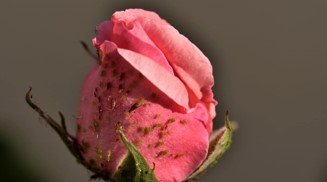 Signs of aphid damage are curled leaves, disfigured buds, or a sticky, black substance on the foliage.
Lifeline + Traps + Meta + BT
Thrips
Signs of aphid damage are curled leaves, disfigured buds, or a sticky, black substance on the foliage.
Lifeline + Traps + Meta + BT
Thrips
 Signs of thrip damage include petals with brown edges or streaks on light-colored roses, and deformed buds that never open.
Lifeline + Traps + Meta + BT
Mealybugs
Signs of thrip damage include petals with brown edges or streaks on light-colored roses, and deformed buds that never open.
Lifeline + Traps + Meta + BT
Mealybugs
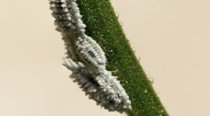 Mealybugs create cotton-looking lumps on the stems, branches, and leaves. These pests love to drink the juices from the leaves and stems of plants, leading to weak growth.
Traps + Meta
Spider Mites
Mealybugs create cotton-looking lumps on the stems, branches, and leaves. These pests love to drink the juices from the leaves and stems of plants, leading to weak growth.
Traps + Meta
Spider Mites
 Dull, brown or yellow leaves. The undersides have sticky white webs. Rub a leaf with suspected infestation between your fingers. If it leaves a rusty residue, you likely have spider mites.
Acarida+ Traps + Meta + BT
Cane Borers
Dull, brown or yellow leaves. The undersides have sticky white webs. Rub a leaf with suspected infestation between your fingers. If it leaves a rusty residue, you likely have spider mites.
Acarida+ Traps + Meta + BT
Cane Borers
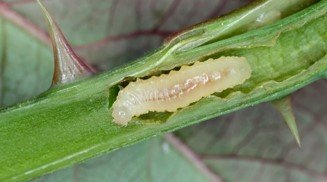 Borer damage shows up in the form of brown, dried-out, dying canes. Look for a hole in the center of the cane where the borer tunneled down to lay its eggs. You may also see swelling or blotches on the dead cane.
Traps + Meta + BT
Budworms
Borer damage shows up in the form of brown, dried-out, dying canes. Look for a hole in the center of the cane where the borer tunneled down to lay its eggs. You may also see swelling or blotches on the dead cane.
Traps + Meta + BT
Budworms
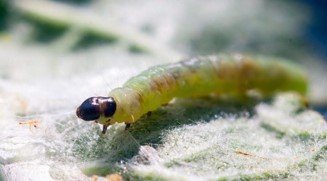 Budworms are most active at dusk and at night, eating oval-shaped holes in blooms or devouring them completely. They often leave behind globs of black droppings on damaged petals.
BT + Meta
Scale
Budworms are most active at dusk and at night, eating oval-shaped holes in blooms or devouring them completely. They often leave behind globs of black droppings on damaged petals.
BT + Meta
Scale
 Scale insects pierce rose canes and feed on the juices, resulting in weakened plants. Fortunately, healthy roses can tolerate light rose scale infestations.
Traps
Sawfly Larvae
Scale insects pierce rose canes and feed on the juices, resulting in weakened plants. Fortunately, healthy roses can tolerate light rose scale infestations.
Traps
Sawfly Larvae
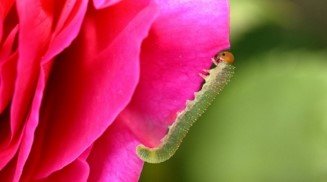 If you have white to tan blotches or transparent circles on your rose leaves, look for small green caterpillar-like larvae with brown-orange heads, especially on the undersides.
Indofa + Bacillus
Root-knot Nematode
If you have white to tan blotches or transparent circles on your rose leaves, look for small green caterpillar-like larvae with brown-orange heads, especially on the undersides.
Indofa + Bacillus
Root-knot Nematode
 Stunting, slow growth, pale green leaves, and wilting in mild weather.
Meta + BT + Pacliq
Crown Gall Rot
Stunting, slow growth, pale green leaves, and wilting in mild weather.
Meta + BT + Pacliq
Crown Gall Rot
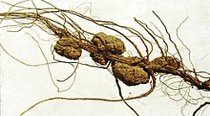 This disease is characterized by large lumps at the base of the plant stem or on roots. Galls may appear higher on stems as the disease progresses.
Meta + BT + Pacliq
Black Spot
This disease is characterized by large lumps at the base of the plant stem or on roots. Galls may appear higher on stems as the disease progresses.
Meta + BT + Pacliq
Black Spot
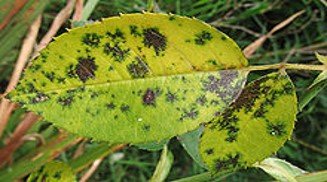 Leaves frequently turn yellow and fall early. Sometimes new leaves are produced, and these may also become affected.
Indofa + Bacillus
Powdery Mildew
Leaves frequently turn yellow and fall early. Sometimes new leaves are produced, and these may also become affected.
Indofa + Bacillus
Powdery Mildew
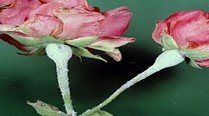 Attacks on young leaves and buds will cause deformity with retardation of growth. Infected buds will fail to open. The disease is likely in hot, humid weather, with fungal spores overwintering on the stems and fallen leaves.
Indofa + Bacillus
Anthracnose
Attacks on young leaves and buds will cause deformity with retardation of growth. Infected buds will fail to open. The disease is likely in hot, humid weather, with fungal spores overwintering on the stems and fallen leaves.
Indofa + Bacillus
Anthracnose
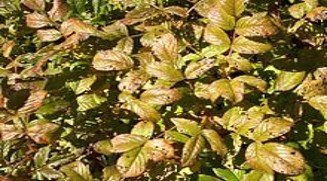 Spots caused by this fungus originate from a point where leaves are water-soaked, usually unnoticeable at first, until they turn black with a very distinct defined edge. As the spots enlarge the center becomes grey and may fall out resulting in a shot-hole appearance.
Indofa + Bacillus
Spots caused by this fungus originate from a point where leaves are water-soaked, usually unnoticeable at first, until they turn black with a very distinct defined edge. As the spots enlarge the center becomes grey and may fall out resulting in a shot-hole appearance.
Indofa + Bacillus
 Signs of aphid damage are curled leaves, disfigured buds, or a sticky, black substance on the foliage.
Lifeline + Traps + Meta + BT
Thrips
Signs of aphid damage are curled leaves, disfigured buds, or a sticky, black substance on the foliage.
Lifeline + Traps + Meta + BT
Thrips
 Signs of thrip damage include petals with brown edges or streaks on light-colored roses, and deformed buds that never open.
Lifeline + Traps + Meta + BT
Mealybugs
Signs of thrip damage include petals with brown edges or streaks on light-colored roses, and deformed buds that never open.
Lifeline + Traps + Meta + BT
Mealybugs
 Mealybugs create cotton-looking lumps on the stems, branches, and leaves. These pests love to drink the juices from the leaves and stems of plants, leading to weak growth.
Traps + Meta
Spider Mites
Mealybugs create cotton-looking lumps on the stems, branches, and leaves. These pests love to drink the juices from the leaves and stems of plants, leading to weak growth.
Traps + Meta
Spider Mites
 Dull, brown or yellow leaves. The undersides have sticky white webs. Rub a leaf with suspected infestation between your fingers. If it leaves a rusty residue, you likely have spider mites.
Acarida+ Traps + Meta + BT
Cane Borers
Dull, brown or yellow leaves. The undersides have sticky white webs. Rub a leaf with suspected infestation between your fingers. If it leaves a rusty residue, you likely have spider mites.
Acarida+ Traps + Meta + BT
Cane Borers
 Borer damage shows up in the form of brown, dried-out, dying canes. Look for a hole in the center of the cane where the borer tunneled down to lay its eggs. You may also see swelling or blotches on the dead cane.
Traps + Meta + BT
Budworms
Borer damage shows up in the form of brown, dried-out, dying canes. Look for a hole in the center of the cane where the borer tunneled down to lay its eggs. You may also see swelling or blotches on the dead cane.
Traps + Meta + BT
Budworms
 Budworms are most active at dusk and at night, eating oval-shaped holes in blooms or devouring them completely. They often leave behind globs of black droppings on damaged petals.
BT + Meta
Scale
Budworms are most active at dusk and at night, eating oval-shaped holes in blooms or devouring them completely. They often leave behind globs of black droppings on damaged petals.
BT + Meta
Scale
 Scale insects pierce rose canes and feed on the juices, resulting in weakened plants. Fortunately, healthy roses can tolerate light rose scale infestations.
Traps
Sawfly Larvae
Scale insects pierce rose canes and feed on the juices, resulting in weakened plants. Fortunately, healthy roses can tolerate light rose scale infestations.
Traps
Sawfly Larvae
 If you have white to tan blotches or transparent circles on your rose leaves, look for small green caterpillar-like larvae with brown-orange heads, especially on the undersides.
Indofa + Bacillus
Root-knot Nematode
If you have white to tan blotches or transparent circles on your rose leaves, look for small green caterpillar-like larvae with brown-orange heads, especially on the undersides.
Indofa + Bacillus
Root-knot Nematode
 Stunting, slow growth, pale green leaves, and wilting in mild weather.
Meta + BT + Pacliq
Crown Gall Rot
Stunting, slow growth, pale green leaves, and wilting in mild weather.
Meta + BT + Pacliq
Crown Gall Rot
 This disease is characterized by large lumps at the base of the plant stem or on roots. Galls may appear higher on stems as the disease progresses.
Meta + BT + Pacliq
Black Spot
This disease is characterized by large lumps at the base of the plant stem or on roots. Galls may appear higher on stems as the disease progresses.
Meta + BT + Pacliq
Black Spot
 Leaves frequently turn yellow and fall early. Sometimes new leaves are produced, and these may also become affected.
Indofa + Bacillus
Powdery Mildew
Leaves frequently turn yellow and fall early. Sometimes new leaves are produced, and these may also become affected.
Indofa + Bacillus
Powdery Mildew
 Attacks on young leaves and buds will cause deformity with retardation of growth. Infected buds will fail to open. The disease is likely in hot, humid weather, with fungal spores overwintering on the stems and fallen leaves.
Indofa + Bacillus
Anthracnose
Attacks on young leaves and buds will cause deformity with retardation of growth. Infected buds will fail to open. The disease is likely in hot, humid weather, with fungal spores overwintering on the stems and fallen leaves.
Indofa + Bacillus
Anthracnose
 Spots caused by this fungus originate from a point where leaves are water-soaked, usually unnoticeable at first, until they turn black with a very distinct defined edge. As the spots enlarge the center becomes grey and may fall out resulting in a shot-hole appearance.
Indofa + Bacillus
Spots caused by this fungus originate from a point where leaves are water-soaked, usually unnoticeable at first, until they turn black with a very distinct defined edge. As the spots enlarge the center becomes grey and may fall out resulting in a shot-hole appearance.
Indofa + Bacillus
NUTRITION DEFICIENCY
NUTRIENT
IDENTIFICATION
SYMPTOMS
SUGGESTED PRODUCT
Nitrogen
 Similar to iron deficiency but not as chlorotic.
Azoss
Iron
Similar to iron deficiency but not as chlorotic.
Azoss
Iron
 Interveinal areas show chlorosis, while the veins remain green.
Alp
Manganese
Interveinal areas show chlorosis, while the veins remain green.
Alp
Manganese
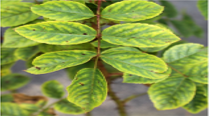 Similar to iron deficiency. Common in poorly drained soils and when pH is high.
Alp
Potassium
Similar to iron deficiency. Common in poorly drained soils and when pH is high.
Alp
Potassium
 In mature plants leaf margins become yellow then turn brown to purple.
Potash Grow
Phosphorus
In mature plants leaf margins become yellow then turn brown to purple.
Potash Grow
Phosphorus
 In mature plants, older foliage drops off without turning yellow.
PSB Plus
In mature plants, older foliage drops off without turning yellow.
PSB Plus
 Similar to iron deficiency but not as chlorotic.
Azoss
Iron
Similar to iron deficiency but not as chlorotic.
Azoss
Iron
 Interveinal areas show chlorosis, while the veins remain green.
Alp
Manganese
Interveinal areas show chlorosis, while the veins remain green.
Alp
Manganese
 Similar to iron deficiency. Common in poorly drained soils and when pH is high.
Alp
Potassium
Similar to iron deficiency. Common in poorly drained soils and when pH is high.
Alp
Potassium
 In mature plants leaf margins become yellow then turn brown to purple.
Potash Grow
Phosphorus
In mature plants leaf margins become yellow then turn brown to purple.
Potash Grow
Phosphorus
 In mature plants, older foliage drops off without turning yellow.
PSB Plus
In mature plants, older foliage drops off without turning yellow.
PSB Plus


